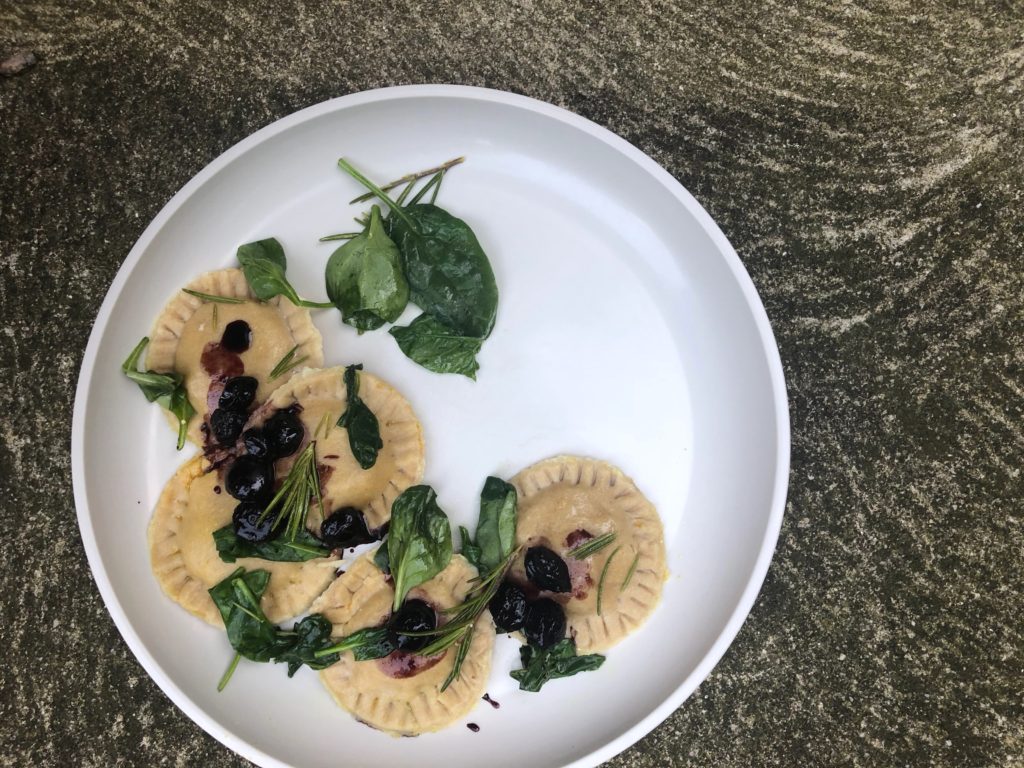Kabocha Squash Ricotta Ravioli
Welcome autumn with some spiced up pasta.

The September equinox just passed, so that means fall has just arrived! As much as I’ll miss the warmth of summer, I’m sure many of us are ready for sweater weather, falling leaves, and pumpkin spice everything. I LOVE various types of squash, especially kabocha squash (also known as Japanese pumpkin), which really thrive in the cooler climate of fall and winter and will put it in everything I cook and eat.



To kick things off, here’s a perfectly autumn-y, sweet-and-spicy recipe (originally published on my blog) to kick off the arrival of fall. This ravioli’s creamy ricotta and squash filling will leave you satisfied especially paired with a sweet and sour blueberry balsamic reduction. It’s perfect for when you’re craving some delicious, warm carbs and is best enjoyed sitting by the fireplace or a lit pumpkin spice candle with a glass of wine on the side.
Not to mention, ravioli are incredibly fun to make (especially with friends) so give this recipe a try!


Ingredients:
For the Dough
-
- 2 cups whole wheat flour
-
- 3 eggs
- A little bit of water
For the Filling
-
- 1 cup mashed kabocha squash
-
- 1/2 cup ricotta (whole milk will be creamier but part-skim will work!)
- 1 tsp cinnamon powder
For the sauce
-
- Reduction
-
- 1 1/2 cups balsamic vinegar
- 1 cup blueberries (frozen is fine!)
Extras
-
- Olive oil
-
- Spinach (can’t forget about the greens!)
- Rosemary
Instructions:
To make the ravioli
-
- Start by making the filling because it needs to be steamed for a while. Cut your kabocha squash into medium-sized chunks (about 1 inch by 2.5 inches). (This might be kind of difficult so use a large knife and maybe a mallet, I’m not kidding.)
- Put the chunks in a bowl and steam it with a cup of water. If you don’t have a multi-cooker, you can also bake or boil your squash.
- While your squash is cooking, start prepping your pasta dough.
- Prepare your work surface. If you have a plastic rolling mat, use that. If not, you can use wax paper on top of a clean work surface (like a table or cutting board)!
- Start by making the dough. Measure out the flour by scooping out of bag into measuring cup. Make a mound of flour and make a well in the middle. (Not-so-pro tip: it might be easier to use a bowl to prevent any leakage.)
- Crack 3 eggs into the well and then beat them. Use your hands to push flour into center and knead it until your dough is smooth and moist. Make sure to use extra flour to prevent your pasta dough from sticking to the bowl or your work surface.
- Wrap your dough in saran wrap or if you want to be more environmentally friendly, sprinkle flour in some tupperware or lidded bowl and keep it covered. Let your dough rest for about 30 minutes.
- Take this time to finish making your filling! When your squash is done, it should be tender and soft. Remove the skin and mash your squash with your fork. Make sure you have about a cup of squash.
- Measure out a cup of ricotta, 1 tsp of ground cinnamon, and mix it with your squash.
- Now set your filling aside and shape your pasta dough. Cut your dough ball into four pieces. Take one piece and roll it out into a thin sheet. Ideally, you would use a pasta maker. If you don’t have one, roll it out with a rolling pin and if you don’t have that you can use a bottle (I used my Hydroflask ¯_(ツ)_/¯). Make sure you’re always using flour to prevent sticking.
- Cut out individual circles with a cookie cutter or glass/jar.
- Fill half of your circles with a scoop of filling and using the other half of the dough, cover the dough with the filling, slightly flattening the ravioli, and seal the edges with a fork. If there’s a lot of excess dough or if you want to just refine the circular shape a bit, you can press the edges with the jar to cut off the excess pasta.
- Repeat this process with the other 3 quarters of the dough.
- Your ravioli is finished! Boil some water, put your ravioli in (not too many so they don’t stick), bring the water down to a simmer, let the ravioli cook for a few minutes (making sure to stir regularly to prevent the pasta from sticking to the pot). When it is finished, the ravioli should float.
To make the blueberry balsamic reduction
-
- Pour your balsamic vinegar into a small saucepan and put your burner on medium heat. Let it boil and then simmer for about 10-15 minutes – the vinegar should start to thicken.
- Add in blueberries. Frozen blueberries will work as long as you get rid of excess ice or water that may be stuck to them. Let simmer for another 5-7 minutes.
- Now you should have a thick, sweet and sour sauce that will go great drizzled on top of your slightly sweet ravioli!
Putting it all together
-
- After draining your ravioli, add some olive oil to a saucepan on medium heat. Add in your ravioli, some spinach, and a few sprigs of rosemary. Briefly pan fry these ingredients, making sure to stir so that your ravioli don’t stick and so that both sides get some oil and heat (around 3 minutes).
- Remove the contents of the saucepan and drizzle some of your blueberry balsamic reduction on top. Enjoy!